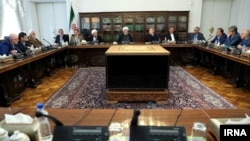Two members of the Iranian parliament (Majles) say a closed door session of the Majles has decided on Sunday December 16 to deposit only 10 percent of the country's oil revenue into the National Development Fund rather than the 34 percent required by law.
The National Development Fund was set up to convert part of the oil and gas revenue into sustainable wealth that would be invested on productive economic activities that would guarantee the next generations' wellbeing.
Alireza Salami, MP for Mahallat told Tasnim news agency that the budget bill for the year starting on 21 March 2019 has "illegally reduced" the amount to be deposited into the strategically important fund.
Previously, Fars news agency had reported that the government' economic coordination council where the heads of judiciary, executive and legislative branches are represented, had rejected depositing even the 10 percent into the fund due to "an eye-catching decline in oil export."
Earlier reports indicated that Iran's Supreme Leader Ayatollah Ali Khamenei allocated part of the fund to military spending.
Radio Farda's military analyst Hossein Aryan had said at the time that the government has withdrawn 2.5 billion dollars out of the National Development Fund to spend on Iran's military ambitions in Syria.
New withdrawals from the fund for military purposes takes place while the projected oil export next year is about half of what Iran exported in the first half of 2018.
Other reports during the past year said that $2.5 billion for military and another $4 billion was withdrawn from the fund to be spent mainly on Iran's national broadcaster IRIB (The Islamic Republic of Iran's Broadcasting) which is used mainly to spread the Islamic Republic's propaganda in Iran and abroad.
Critics say military and propaganda spending should have come from the general budget rather than a fund designed for the future and for emergency situations.
No one knows exactly how much money is in the development fund. When Rouhani was elected in 2013, he announced that the fund was completely drained during the presidency of populist Mahmoud Ahmadinejad. But if from 2016 when previous sanction were lifted, the government really deposited one-third of the oil income in the fund, there must be at least $20 billion now.
The news about withdrawal from the National Development Fund surfaced while Vice-President Mohammad Baqer Nobakht who chairs Iran's Planning and Budget Organization has said that the government's income has been reduced to one third as a result of the reimposed US sanctions.
Behrouz Nemati the spokesman for the Majles Presidium told reporters on Wednesday that the new budget bill would be presented to the Majles only after amendments requested by Khamenei are made. Meanwhile, he added on Sunday that the heads of the three branches of government held a meeting with members of the Majles research center and the parliament's economic committee to discuss the amendments. However, he did not elaborate on the outcome of the meeting.
Based on minimal information given away to the press so far, next year’s 4,330,000 billion rials (about $76 billion) budget is drawn based on selling one to 1.5 million barrels of oil per day (One million barrel less than the figure in the current year's budget bill) at a projected price of $54 per barrel (a dollar less than the price in this year's budget), but all this may change as a result of future developments and the way US sanctions affect Iran's oil exports.




